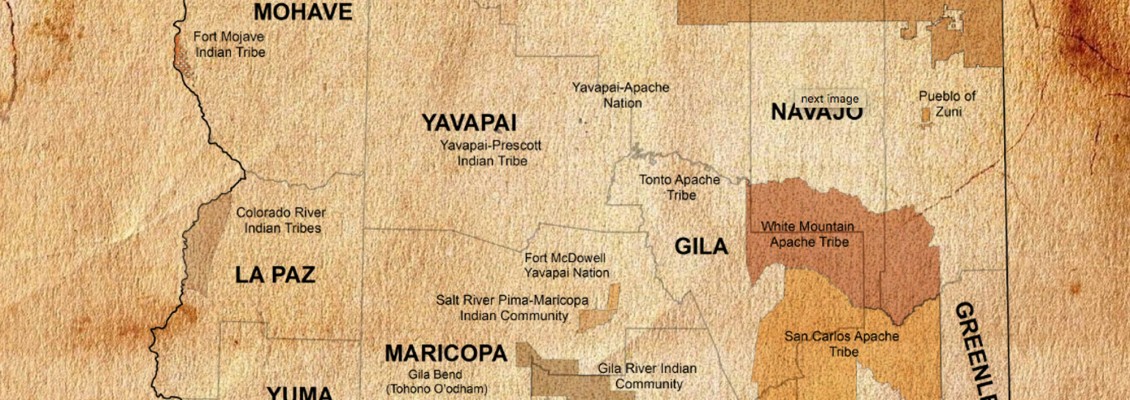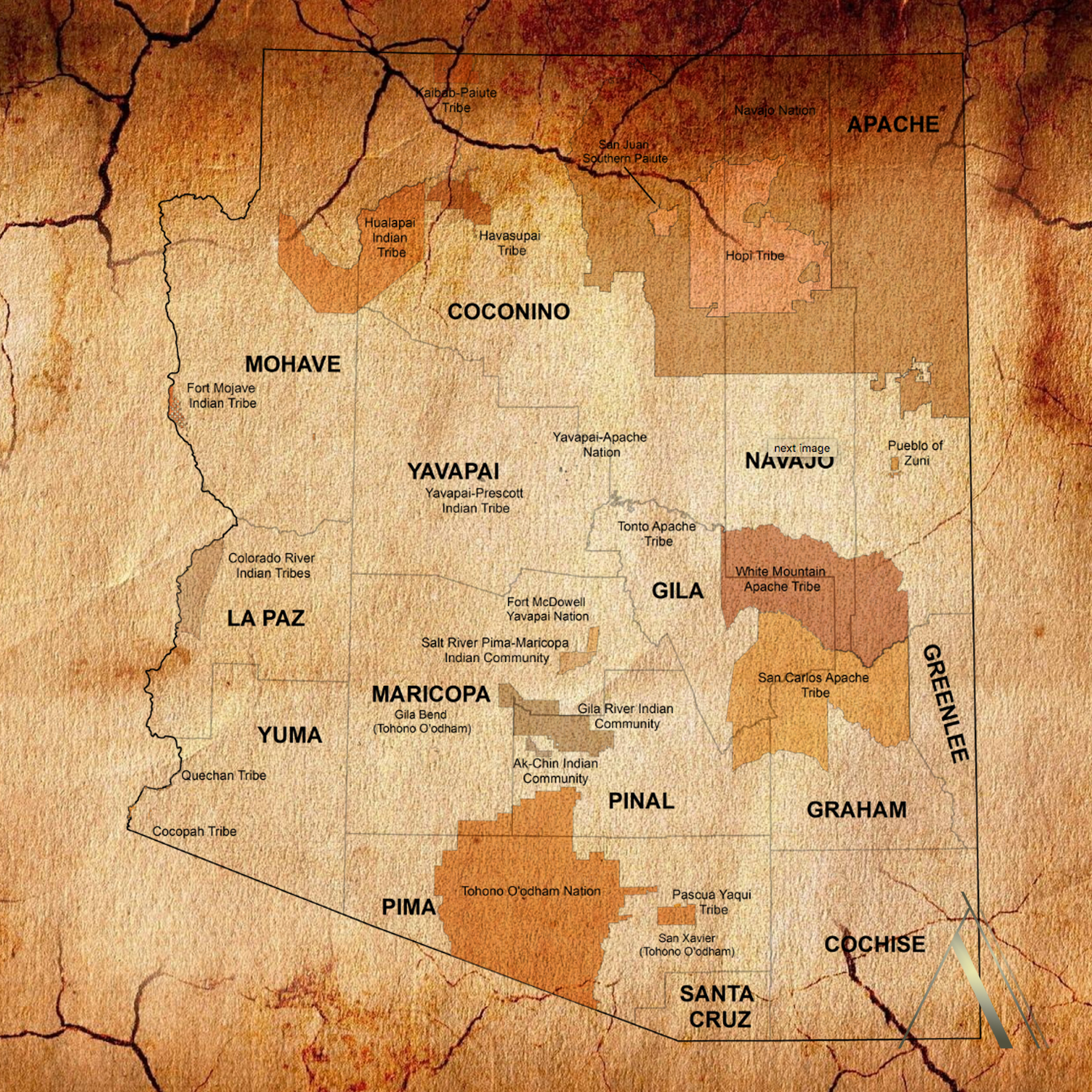

Tribes of Arizona
Tribes - there are 21 Federally recognized Tribes in the State of Arizona. At last count there were approximately 571 Federally recognized Tribes in the United States of America. Tribes that are Federally recognized are protected from various impositions including an encroachment on their art.
Each tribe has its own distinct language, culture and religion. Contrary to Hollywood not all tribes live in teepees nor do they all speak the same language. Some of the more nomadic tribes may have bands in different areas. Through this nomadic lifestyle and the misunderstanding it created, some tribes were grouped together when the reservations were created. Today these tribes have learned how to live together and yet maintain separate cultural identities while incorporating both lifestyles together. Members of these tribes have intermarried and acknowledge the heritage of the various cultures. An example would be the number of tribes that have Apache crown dancers. Since groups of Apache people are in each of these tribes they’ve maintained the Crown Dance ceremony. However, since there are differences in the way these ceremonies are carried out there are subtle differences that a lay person would not pick up on yet an Apache person would immediately notice.
-
White Mountain Apache
-
San Carlos Apache
-
Fort McDowell Yavapai Apache
-
Yavapai-Apache -
-
Yavapai Prescott Apache
-
Tonto Apache
-
Fort Mohave
-
Colorado River Indian Tribes (Chemehuevi, Hopi, Mohave, Navajo)
-
Gila River Indian Community
-
Salt River Pima Maricopa Indian Community
-
Ak Chin Pima
-
Hopi
-
San Juan Southern Paiute
-
Cocopah
-
Havasupai
-
Hualapai
-
Tohono O’odham Nation
-
Pascua Yaqui
-
Fort Yuma Quechan
-
Navajo
-
Kaibab Paiute
Currently we work with artists from the Navajo Nation and the Hopi Tribe on a regular basis.
Traditionally artists of the Navajo Nation are known for woven rugs, using handspun wool and silver jewelry.
With the introduction of sheep Navajo people learned the art of weaving textiles and have become very adept and are known worldwide for their rug weaving. Various designs come from specific areas of the reservation. Real Navajo rugs are very expensive even when bought on the reservation. They are woven by Navajo women on handmade looms that were traditionally hung outside a hogan (a traditional Navajo home). Now-a-days Navajo people live in more modern homes and the looms have moved inside the homes. Navajo people carefully tend their sheep because the sheep is used for eating and the wool is used to make these rugs. A Navajo woman is taught from a young age all the steps in making a Navajo rug. They are adept in sheep shearing, wool cleaning, carding, dying, spinning and weaving the wool. It is very rare for a Navajo woman to use anything but handmade supplies in a woven rug.
Both men and women of the Navajo Nation are silversmiths. Traditionally large chunks of turquoise were used in jewelry pieces. Contemporary pieces use smaller lighter stones since this is what the customer wants. Navajo jewelers have the ability to adapt to the changing buying needs of the consumer and readily do so. They use various stones in their work incorporating traditional and contemporary designs.
Hopi artists are usually homeschooled in their arts; sitting by the side of their grandmother/mother or grandfather/uncle, learning from an early age. Traditionally arts were divided by gender with females making pottery, woven baskets, willow baskets and woven plaques. These arts were further divided by the village or mesa the female is from e.g. potters came from 1st Mesai; sifter baskets and coiled plaques came from 2nd Mesa and 3rd Mesa women made the wicker plaques. Traditionally men of all villages are weavers, carvers, moccasin makers and in later time jewelers.
Traditionally pottery is made from clay gathered in the northern part of Arizona. Hopi pottery is hand molded and handpainted. Baskets are made from plants that are also collected in the northern part of Arizona. The woven textiles were initially made from cotton. Use of wool came with the arrival of the Spaniards and sheep. Most Hopi textiles still use cotton the exception to that is the Hopi manta (a woman’s dress) which is made from wool.
Contemporary art may use commercially purchased materials but still use the old style techniques. For example clay may be purchased from a store and yet the coil and scrape method is still used. In basketry commercial dyes may be used in order to gain a more vibrant color however, plants are still gathered and used in the overall making of the piece. Commercially purchased paints may be used in katsina carvings. Another contemporary design is the one piece three dimension katsina doll.
Hopi overlay is a relatively new art form. The overlay is a distinct method used by Hopi silversmiths. This method takes two layers of silver one layer used for the cutout design and the other layer used as a backing, the backing is etched and oxidized to create the black background color on the piece.
Use of contemporary means is a concern because it goes against the philosophy of working hard for what you produce. Hopi prophecy talks about how in the future things will be so easy and Hopi will forget how to work hard to get the things they need. For these reasons many Hopi artisans still use the old techniques in order to continue the way of life for as long as possible. To Hopi, art is not a means of economic advantage first and foremost. Rather it is a means of keeping religion and culture alive using knowledge that was received from those that preceded modern day Hopi. As a result the Hopi people are less likely to adapt to the changing ways of the consumer.






Leave a Comment